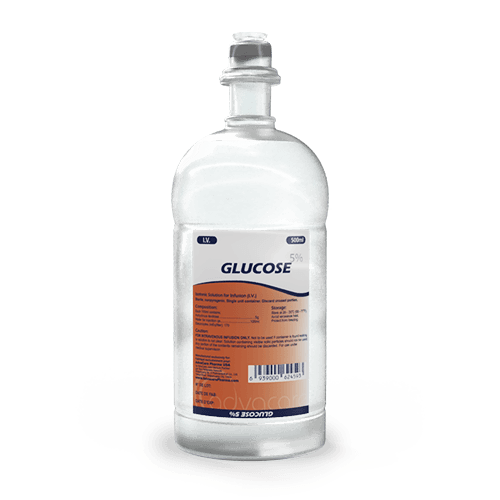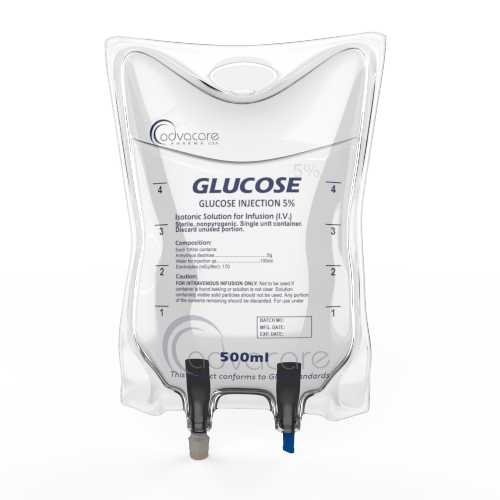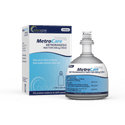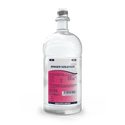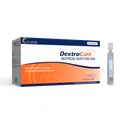- Home›
- Pharmaceuticals›
- Injections›
- Large Volume Injections›
- Dextrose Injection
Dextrose Injection
Dosage
Packaging
What is Dextrose?
Active Ingredients: Glucose (Dextrose)
Dextrose Injection is a sterile, non-pyrogenic solution used as a parenteral fluid and nutrient replenisher. It provides a source of calories and water in order to treat or prevent hypoglycemia and dehydration. It is often used to dilute compatible medical products for parenteral administration.
Dextrose is a form of sugar (glucose) that is derived from corn. It may also be called D-glucose. It is chemically similar to blood sugar, which is required for normal bodily functions. This compound is easily metabolized and may help decrease the loss of protein and nitrogen within the body. In addition, dextrose helps to promote glycogen deposition and can prevent or decrease ketosis.
Dextrose (Glucose) Injection is composed of hydrous dextrose and water. The solution does not contain antimicrobial agents or added buffer. Dextrose Injections are available in three concentrations: 5%, 10%, and 20%.
For the 5% Dextrose Injection, 100mL contains 5g hydrous dextrose in water for injection. The caloric value is 170kcal/L. The osmolarity is 252mOsmol/L, and the concentration is isotonic.
For the 10% Dextrose Injection, 100mL contains 10g hydrous dextrose in water for injection. The caloric value is 340kcal/L. The osmolarity is 505mOsmol/L, and this concentration is hypertonic.
For the 20% Dextrose Injection, 100mL contains 20g hydrous dextrose in water for injection. The caloric value is 680kcal/L. The osmolarity is 1010mOsmol/L, and this concentration is hypertonic.
Dextrose concentrations of 5-20% have a pH of 3.5 ‐ 6.5.
This medicine has been manufactured as a single-dose container for intravenous administration. Single-dose containers are available in 4 different volumes: 100ml, 250ml, 500ml, and 1000ml.
AdvaCare Pharma also produces Glucose Saline Injection, which is suitable for parenteral replenishment.
AdvaCare Pharma is a trusted global supplier of Glucose (Dextrose) Injection. We offer a wide range of high-quality and cost-effective medical supplies that are available for distribution. Our factories are GMP-certified. We regularly inspect our facilities to ensure they meet the high standards necessary to comply with WHO guidelines and standards.
Why are we a quality Dextrose manufacturer?
AdvaCare Pharma is a leading manufacturer of Dextrose Injection. For 20 years, we have been in the business of manufacturing GMP-approved high-quality, affordable pharmaceutical injection products to improve healthcare worldwide. Our control of the supply chain is data-driven and methodical, supported by highly skilled teams of professionals.
As a large-scale Dextrose manufacturer, we supply pharmaceutical distributors, hospitals, pharmacies and other medical organizations in more than 65 countries.
Uses
What is Dextrose used for?
It is used to treat or prevent dehydration (loss of body fluids) and hypoglycemia (low blood sugar levels).
Dextrose 5% is typically used for non-electrolyte fluid replacement and as a carrier for medication delivery. Dextrose 10% and above are used as an energy source for parenteral nutrition with minimal dilution effect. It is also used with a nitrogen source to prevent nitrogen loss in certain patients. Dextrose 20% can also be administered to temporarily relieve symptoms due to cerebral edema and hypoglycemic coma.
Can Dextrose Injection be used in emergency situations, such as in cases of diabetic ketoacidosis?
Yes, Dextrose Injections are used for emergency situations, including for the treatment of diabetic ketoacidosis (DKA). DKA is a serious and potentially life-threatening complication of diabetes mellitus.
Can Dextrose Injection be administered to athletes for energy replenishment?
IV therapy is commonly used by athletes in order to replenish bodily fluids in order to treat or prevent dehydration. Competitive athletes exhibit an increased risk of dehydration, which may impact muscle recovery or lead to muscle damage or kidney problems. Dextrose may be added to IV therapy in order to replenish glycogen.
It is important to note that there are limited studies and data concerning the use of Dextrose Injection as an ergogenic aid for athletes.
How should Dextrose Injection be used?
This medication is manufactured as a solution, which should only be administered by a doctor or healthcare provider.
This product is intended for intravenous use only. Do not administer by IM or SC routes.
The solution should be carefully inspected for any discoloration or particulate matter. Any compromised containers should be discarded. Do not use it if the seal is not intact.
Before treatment, it is essential to dilute Dextrose Injections of over 10% with compatible intravenous fluids. They can also be used as an admixture with amino acids. It is important to note that some additives may be incompatible. Some reported incompatibilities include hydralazine, amoxicillin + clavulanic acid, aciclovir, phenytoin, bleomycin, and chloroquine.
The aseptic techniques should be used when introducing additives. The solution should be mixed thoroughly and used immediately. Do not store the solutions containing additives.
In emergency situations, it is generally acceptable to administer hypertonic (< 10%) dextrose slowly via a peripheral vein. If the solution is administered peripherally, a large arm vein should be used, and the injection site should be alternated each day. Hypertonic solutions (Dextrose > 10%) are intended to be administered via an intravenous catheter in a large central vein.
How should Dextrose Injections be stored?
It is advised to store this product between 15-25˚C. Do not freeze the solution. The product should be kept out of excessive heat.
What dose should be given?
For hypoglycemia, the usual dose is as follows:
- adults: 10-25g, IV. If BGL < 4mmol/L after 5-10 minutes, 10g V should be given, titrating to effect.
- adolescents: 10-25g, IV.
- children and infants over 6 months: 0.5-1g/kg, IV. The maximum dosage is 25g per dose.
- infants under 6 months: 0.25-0.5g/kg per dose. The maximum dosage is 25g per dose.
- newborns: 0.20g/kg per dose. The dose can be repeated only once if clinically indicated.
For the reversal of hypoglycemic coma, the usual dose is up to 125ml of dextrose 20% w/v.
When used as a diluent, the dosage and rate will be determined by the additive and prescribed drug. For reference, a 5% infusion solution can be administered IV at a rate of 0.5g/kg per hour in healthy patients. The maximum infusion rate should not exceed 0.8g/kg per hour.
Refer to a doctor or pharmacist for guidelines on dosage. Do not exceed what they recommend.
Who can use Dextrose Injection?
Dextrose Injection can be administered to adults and children, but caution is advised for specific groups of patients.
Pregnant Dextrose Injection should only be administered to a pregnant woman only if there is a clear need. There have not been animal studies done to assess the risk of fetal harm or the effect on reproduction capacity.
Labor/Delivery Dextrose Injections have been given during labor and delivery. It is advised to use caution and to regularly monitor the fluid balance, glucose and electrolyte concentrations, and acid-base balance of the mother and fetus.
Breastfeeding Many drugs are known to be excreted in milk. Express caution when administering dextrose to nursing mothers.
Children There is a known increased risk of hypoglycemia/hyperglycemia in this population. It is recommended to monitor serum glucose concentrations during treatment.
Geriatric In general, it is recommended to exercise caution when selecting dosage, as there is a greater incidence of hepatic, renal, and cardiac function among this population.
Other warnings
For hyperglycemia or hyperosmolar hyperglycemic states, it is recommended to monitor blood glucose. Insulin should be administered as needed.
Do not administer dextrose simultaneously with blood through the same infusion set. Hemolysis or pseudoagglutination may occur.
It is recommended to administer 5% or 10% dextrose when highly concentrated dextrose infusions are abruptly withdrawn in order to avoid reactive hypoglycemia.
When infusing medication, caution is advised to avoid air embolism.
If a stable patient experiences an unexpected rise in blood glucose level, it is recommended to monitor for signs and symptoms of infection.
Side Effects
As with all pharmaceuticals, some unwanted effects can occur from the use of Dextrose Injection.
Side effects may be due to the solution or the administration technique. Common reactions include, but may not be limited to:
- febrile response
- infection at the injection site
- venous thrombosis or phlebitis extending from the injection site
- extravasation
- hypervolemia
Signs of a serious side effects may include:
- hypersensitivity reactions, including a serious allergic reaction called anaphylaxis
- difficulty breathing
- swelling of the face, lips and throat, fever (pyrexia)
- hives (urticaria)
- skin rash
- redness of the skin (erythema)
- chills
For a comprehensive understanding of all potential side effects, consult a medical professional.
If any symptoms persist or worsen, or you notice any other symptoms, please call your doctor immediately.
Precautions
Do NOT use Dextrose Injection if:
- You are allergic to any of the ingredients.
- You have a known allergy to corn or corn products.
- You have uncontrolled diabetes.
- You have uncompensated diabetes.
- You have hyperosmolar coma (unconsciousness).
Before treatment, consult your doctor regarding any medications you are taking to address potential drug interactions.Some known drug interactions exist with medications associated with an increased vasopressin effect, such as antipsychotics, narcotics, non-steroidal anti-inflammatory drugs (NSAIDs), and vasopressin analogs. Diuretics and antiepileptics are also known to have some interactions.
This medication may not be suitable for people with certain conditions, so it is important to consult with a doctor if you have any health conditions. Some medical conditions that may need additional monitoring or consideration include diabetes, hyperglycemia (high blood sugar), hypokalemia (low potassium in the blood), peripheral edema (swelling in arms, feet, or lower legs), or pulmonary edema (fluid in lungs).
This product may contain aluminum, which can accumulate in toxic levels during long-term parenteral therapy in patients with kidney impairment, such as premature neonates.
References
Subcutaneous dextrose for rehydration of elderly patients – an evidence-based review
Saline hypodermoclysis is a relatively common method of rehydration. This review aimed to evaluate the safety and effectiveness of rehydrating elderly patients using subcutaneous 5% dextrose solutions compared to intravenous 5% dextrose solutions.
This review included different studies from databases that provided evidence of the effectiveness of dextrose. The search identified 15 relevant articles, while 4 articles were included in this study.
The four studies provide evidence that appropriate volumes of subcutaneous dextrose infusions (in the form of half-normal saline-glucose 5%, 40 g/L dextrose, and 30 mmol/L NaCl, or 5% dextrose solution and 4 g/L NaCl, or two-thirds 5% glucose and one-third normal saline) can be used for the treatment of dehydration.
This study shows that both subcutaneous and intravenous dextrose can be used for the treatment of dehydration.

You might be interested in...
Why AdvaCare Pharma?
As an industry leader, we are aware of our responsibility to provide affordable and sustainable solutions to improve healthcare worldwide.
